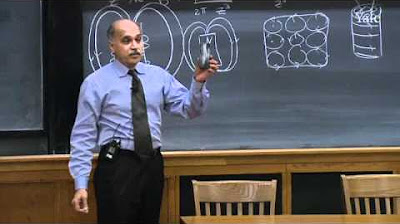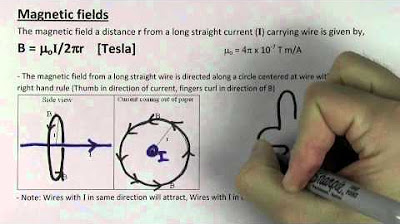Magnetic Torque | Physics with Professor Matt Anderson | M23-08
TLDRThis educational video script explains the physics of a square loop carrying current in a magnetic field. It uses the right-hand rule to determine the direction of forces on each side of the loop, revealing that the net force is zero but a torque is produced due to the perpendicular forces on opposite sides. The script then calculates the torque using the formula \( \tau = I A B \sin(\phi) \), where \( A \) is the area of the loop, \( B \) is the magnetic field strength, \( I \) is the current, and \( \phi \) is the angle between the loop's normal and the magnetic field. The example provided uses specific values for the current, side length of the square, and magnetic field to demonstrate the calculation of torque in newton meters.
Takeaways
- 🔲 A square wire carrying current i is placed in a uniform magnetic field B pointing upwards.
- 📐 The force on each side of the wire is analyzed using the right-hand rule for cross products.
- ⬆️ The force on the top side of the wire is out of the screen.
- ⬇️ The force on the bottom side of the wire is into the screen.
- 🚫 The forces on the sides of the square are zero because the current is parallel or anti-parallel to the magnetic field.
- 🌀 The net force on the loop is zero, but there is a torque causing the loop to rotate in the magnetic field.
- 📏 The side length of the square wire is 0.32 meters, the current is 12 amps, and the magnetic field is 0.25 tesla.
- 💡 The force on the top and bottom sides is calculated as F = iLB, which equals 0.96 newtons for each side.
- 🔄 The torque is calculated by considering the lever arm and force, leading to the formula τ = iAB for a loop at a right angle to the magnetic field.
- 📊 For the given values, the torque is approximately 0.3072 newton-meters.
Q & A
What is the physical setup described in the script?
-The script describes a square loop of wire carrying a current 'i' placed in a uniform magnetic field 'B' that is pointing upwards perpendicular to the plane of the loop.
What is the direction of the magnetic field in the scenario?
-The magnetic field 'B' is described as pointing upwards everywhere around the square loop.
How is the force on the top side of the square loop determined?
-The force on the top side is determined using the right-hand rule, where the thumb points in the direction of the current 'i', the fingers point in the direction of the magnetic field 'B', and the palm faces the direction of the force, which is coming out of the screen.
What is the force experienced by the sides of the square loop that are parallel to the magnetic field?
-The sides of the square loop that are parallel or anti-parallel to the magnetic field experience no force because the force on a current-carrying wire in a magnetic field is perpendicular to both the current and the magnetic field.
Why does the net force on the square loop equal zero?
-The net force on the square loop equals zero because the forces on opposite sides of the loop are equal in magnitude but opposite in direction, resulting in no net movement of the loop.
What type of motion does the square loop experience due to the magnetic field?
-The square loop experiences a torque or twisting motion due to the unbalanced forces on opposite sides, which are trying to rotate the loop in the magnetic field.
What formula is used to calculate the force on each side of the square loop?
-The force on each side is calculated using the formula F = i * l * B * sin(theta), where 'i' is the current, 'l' is the length of the side, 'B' is the magnetic field strength, and 'theta' is the angle between the current and the magnetic field.
What is the calculated force on the top side of the square loop given the values in the script?
-Given the current 'i' of 12 amps, side length 'l' of 0.32 meters, and magnetic field 'B' of 0.25 tesla, the calculated force on the top side is approximately 0.96 Newtons.
How is torque defined in the context of this script?
-Torque in this context is defined as the twisting or rotational force that a body experiences, calculated as the product of the force applied, the lever arm (distance from the axis of rotation), and the sine of the angle between the force and the lever arm.
What is the formula for calculating the torque on a current-carrying loop in a magnetic field?
-The torque on a current-carrying loop in a magnetic field is given by τ = I * A * B * sin(φ), where 'I' is the current, 'A' is the area of the loop, 'B' is the magnetic field strength, and 'φ' is the angle between the normal to the plane of the loop and the magnetic field.
What is the calculated torque on the square loop given the values in the script?
-Using the values provided in the script (current 'I' of 12 amps, area 'A' of 0.32 meters squared, and magnetic field 'B' of 0.25 tesla), the calculated torque is approximately 0.072 Newton meters.
Outlines
🔍 Calculating Forces on a Square Circuit in a Magnetic Field
This paragraph explains the process of calculating the forces on a square wire loop carrying a current 'i' in a uniform magnetic field 'B' pointing upwards. The forces are determined using the right-hand rule, resulting in a force perpendicular to both the current and the magnetic field. The top side of the square experiences a force coming out of the screen, while the bottom side experiences an opposite force going into the screen. The sides of the square experience no force due to their parallel or anti-parallel alignment with the magnetic field. The net force on the loop is zero, but there is a torque due to the opposing forces on the top and bottom sides, which causes the square to rotate in the magnetic field.
📐 Numerical Calculation of Forces and Torque on a Square Loop
The paragraph delves into the numerical calculation of the forces acting on each side of a square loop with side length 'l', carrying a current 'i', in a magnetic field 'B'. Using the formula F = i * l * B * sin(theta), and recognizing that the angle theta between the current and magnetic field is 90 degrees (sine of 90 is 1), the force on the top and bottom sides is calculated to be 0.96 Newtons each. The sides experience no force due to their alignment. The torque on the loop is then calculated using the formula τ = force * lever arm, with the lever arm being half the side length of the square. The net torque is found by adding the torques from the top and bottom sides, resulting in τ = i * A * B, where A is the area of the loop.
🌀 General Formula for Torque on a Loop in a Magnetic Field
This paragraph provides a general formula for the torque experienced by a loop in a magnetic field, which is τ = I * A * B * sin(φ), where φ is the angle between the normal to the plane of the loop and the magnetic field. The paragraph explains that when the loop is perpendicular to the magnetic field, φ equals 90 degrees, and the torque simplifies to τ = I * A * B. An example calculation is provided using specific values for current, area, and magnetic field strength, resulting in a torque of approximately 0.33 Newton meters, highlighting the units of torque as Newton meters.
Mindmap
Keywords
💡Square Circuit
💡Magnetic Field (B field)
💡Current (i)
💡Lorentz Force
💡Torque
💡Right-Angle (90 degrees)
💡Force on Wire
💡Parallel and Anti-Parallel
💡Area of the Loop (A)
💡Phi (Φ)
💡Newton Meters
Highlights
Introduction of a square circuit in a magnetic field (B field) to calculate forces on each side.
Visualization of the square wire carrying current I in a B field pointing upwards.
Application of the right-hand rule to determine the direction of force on the top side of the square.
Explanation of the force on the bottom side being opposite to the top due to the direction of current and magnetic field.
Clarification that the forces on the sides of the square are zero due to parallel and anti-parallel alignment with the magnetic field.
Discussion on the net force on the loop being zero, indicating no translational movement.
Introduction of torque as a result of opposing forces on the square loop in the magnetic field.
Calculation of force on the top side of the square using the formula ILB with sine theta, where theta is 90 degrees.
Numerical example given with side length l = 0.32 meters, current I = 12 amps, and B field = 0.25 Tesla.
Calculation of the force on the top wire using the provided values and the significance of the result.
Mention of the force on the bottom wire being equal in magnitude but opposite in direction to the top wire's force.
Introduction to the concept of torque (τ) as force times lever arm in the context of the rotating square loop.
Explanation of calculating torque on the loop by considering the forces and lever arms on opposite sides of the square.
Derivation of the torque formula for a loop in a magnetic field, i.e., torque = i * area * B.
General formula for torque presented as τ = I * A * B * sin(φ), where φ is the angle between the normal to the plane and the magnetic field.
Application of the torque formula with specific values to calculate the torque experienced by the square loop.
Final calculation of torque with approximated values and the significance of the result.
Reiteration of the units of torque being Newton meters, emphasizing the physical meaning of the calculated value.
Transcripts
5.0 / 5 (0 votes)
Thanks for rating:





